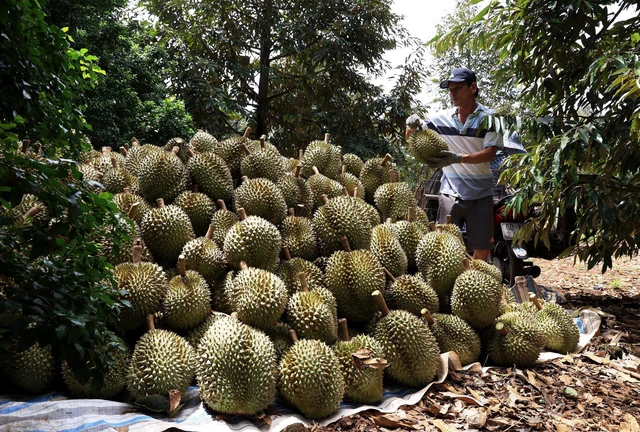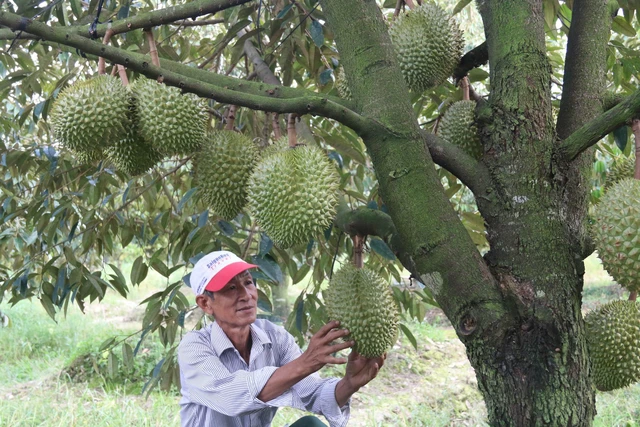In the past 9 months, fruit and vegetable exports are estimated to reach 4.1 billion USD, up nearly 70% over the same period in 2022 and exceeding 24% over the whole year 2022.
China is the largest import market of Vietnamese fruits and vegetables, accounting for 64% of the market share. Next are the US, Korea, and Japan markets.
Durian, banana, and dragon fruit are agricultural products that contribute greatly to growth. In particular, durian ranks first in exports, joining the group of billion-dollar fruits. It is expected that in October, durian will reach a turnover of 1.5 billion USD.
The Vietnam Fruit and Vegetable Association predicts that fruit and vegetable exports will reach about 5 billion USD this year, reaching the target 2 years earlier than planned, in 2025.


The connection to durian consumption is still loose
Market demand is large, so it is understandable that durian prices continuously increase. Traders compete to buy, and those who pay higher prices will sell, leading to farmers breaking contracts with purchasing businesses, causing the chain of links to be broken. At that time, businesses will suffer losses, while farmers will suffer in the following years.
Although he is a member of a cooperative that has been affiliated from the beginning with a reputable enterprise in durian production and purchasing, after considering the pros and cons, Mr. Thuan (Ea Bhok commune, Cu Kuin district, Dak Lak) decided to choose to sell melon to traders.
“When it comes to fertilizing, I don’t need the cooperative to guide me, but when it comes time to buy and sell, the cooperative must come to the garden. However, day by day, month by month, no one is seen,” Mr. Nguyen Van Thuan, Ea Bhok commune, Cu Kuin district, shared.
According to durian farmers, traders often come to the garden 2-3 months before harvest and set prices early. Meanwhile, businesses that have connections from the beginning with farmers and cooperatives arrive very late, half a month before harvest, to assess fruit quality and set prices. Therefore, farmers feel insecure and often rush to sell to traders.
Cooperatives are a bridge between farmers and businesses in purchasing products. However, many cooperatives are in the situation of being turned away by their own members.
“People have a profit mentality, so when promoting purchasing, they want to sell early to be safe. People sell to traders, so they cannot build a value chain for cooperatives and businesses,” said Mr. Nguyen An Thanh, Deputy Director of Van Xuan Cooperative, Cu Kuin district, Dak Lak.
According to businesses, when signing a contract with an exporting country, many factors must be followed, including the output must be large enough, especially the quality must be guaranteed. Therefore, the purchasing process according to the process with farmers will take more time. This does not meet the needs of farmers to buy quickly and sell quickly. If farmers choose traders as their main trading channel, risks are unavoidable, because farmers cannot fully predict market fluctuations.


Maintain linkages in durian production
The fact that farmers choose to sell durian at high prices to traders has caused a lot of worry for export businesses. Only when durian prices dropped did farmers turn to businesses again. In this context, strengthening the connection between people, cooperatives and businesses is considered the optimal solution to maintain stability and help the durian industry develop sustainably.
With more than 1 hectare of durian, this year Mr. Pham Viet Ngoc’s family (Ea Yong commune, Krong Pac district, Dak Lak) collected more than 40 tons of fruit. He said, many traders come to the garden to buy at quite high prices from the beginning of the season. However, he still decided to finalize the purchase price with the cooperative. Because according to many years of experience, selling to cooperatives will be much more stable.
“If the market goes down, the cooperative doesn’t give less, if it goes up, they give. If sold outside, the market is floating. In case the price drops, it is very dangerous, you can lose dozens of prices, the risk is more,” said Mr. Pham Viet Ngoc, Ea Yong commune, Krong Pac district, Dak Lak.
In order to link consumption and export of durian sustainably, durian export businesses need to shift from a mutually beneficial buying and selling relationship to a cooperative relationship, creating trust by coordinating with cooperatives from the beginning. Select varieties, care for products, purchase and sell products.
According to statistics, Dak Lak province currently has about 22,000 hectares of durian, of which over 40% has been harvested. In the coming years, this area may increase, so joint solutions in production are needed. Only then can we control the market and sustainably develop the durian industry, bringing sustainable economic value to farmers.
See more:
